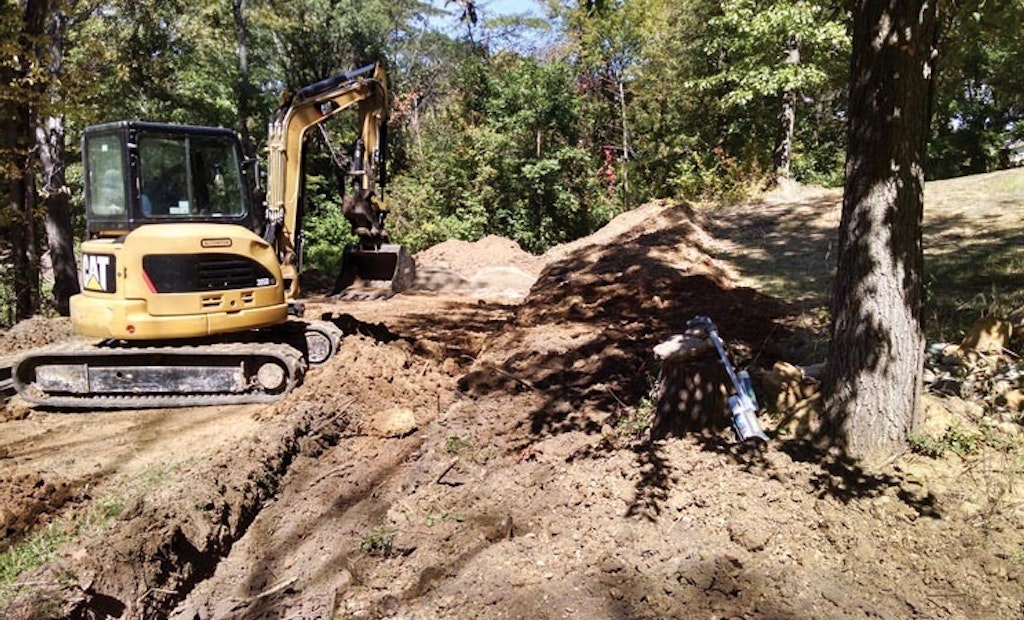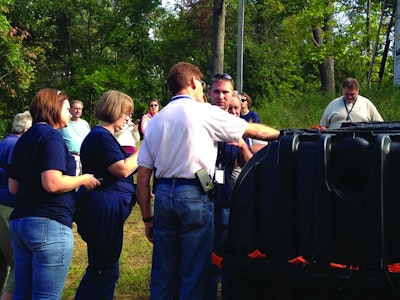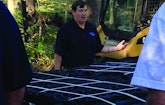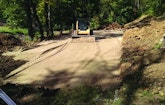
Interested in Systems/ATUs?
Get Systems/ATUs articles, news and videos right in your inbox! Sign up now.
Systems/ATUs + Get AlertsA homeowner building an energy-efficient, three-bedroom house in Riverton, Ill., researched options for a conventional gravity onsite system using no electrical components. He selected sand filter modules from Eljen Corp.
The Illinois Department of Public Health had approved the technology in 2012, but contractors had yet to use it. They preferred aerobic treatment units or low-pressure pipe systems and suggested them to the homeowner. With his mind set on conserving energy, the homeowner kept looking and ran into Rick Maguire of Maguire Backhoe Co. in Virden, Ill. “The soils at the site were so poor that we won’t install in them,” he says. “I jumped at the opportunity to test the modules in those conditions.”
Because this was the first installation of its kind in the state, Maguire turned it into a Field Day approved by the health department for continuing education units. The 95-percent electric, 1,900-square-foot house uses 350 kWh per month at a cost of less than $50.
Site conditions
Soils are Illinois till paleosol with an acceptance rate of 0.27 gpd per square foot. A floodplain is 150 feet from the wooded acre lot and a stream is 30 feet away. The site has no limiting layer.
System components
Maguire worked with Jim King, strategic initiatives manager for Eljen Corp., to design the 600 gpd system. Major components are:
- IM 1,060-gallon single-compartment plastic septic tank (Infiltrator Systems) with EF-4 effluent filter (Tuf-Tite)
- Six-hole distribution box (Tuf-Tite)
- 36 A-42 sand filter modules (Eljen)
System operation
The drop in elevation from the house to the toe of the 2,200-square-foot drainfield is 18 inches. Wastewater flows 15 feet through a 4-inch PVC lateral to the septic tank, then out to the distribution box. It feeds a 4-inch perforated PVC pipe on top of two rows of 18 48- by 24- by 7-inch-high treatment modules, each with an interwoven plastic corrugated core and 64 square feet of geofabric.
Left and right alternating half-inch holes spaced every 12 inches in the pipes drip effluent onto the modules. Liquid seeping through the units discharges into 6 inches of ASTM C-33 washed sand atop native soil. “Compared to conventional absorption systems, the media has approximately eight times more surface area per square foot,” says King.
Installation
Sangamon County Public Health Department publicized the September 2014 Field Day, which attracted 29 installers, pumpers and regulators. Presenters were King and Curtis Cluckey, an area salesman from Infiltrator Systems. Bob Crawford, a representative from Bradford Supply Co. in Bloomington, Ill., provided the septic tank and treatment modules. Maguire supplied the effluent filter and distribution box. All components were purchased.
The day before the event, Maguire stockpiled 120 tons of sand on site. “Sand filter systems cost twice as much as ATUs or LPP systems because of the medium,” he says. “Fortunately, the quarry was nearby, as our semi-tractor trailer made five trips.”
His crew excavated the 22-foot, 6-inch by 90-foot-wide sand bed using a Caterpillar 305 rubber-track mini-excavator. “The soil was slick and smearing because it was hard and dry,” he says. “We had to scarify the bottom with a tooth bucket.”
Workers placed 6 inches of sand with a Caterpillar 259 rubber-track skid-loader then drove over it to compact it. The bed has a 1 percent slope. “We shaved off a corner to avoid setting the modules deeper than 18 inches,” says Maguire.
Attention class
On Field Day, Maguire’s crew excavated the 8- by 12- by 6-foot-deep tank hole. Meanwhile, Cluckey acquainted the contractors with tank assembly, placement, backfill and riser installation.
“He showed how to position the reinforced watertight mid-seam rubber gasket on the 160-pound injection-molded halves to retain the tank’s waterproof warranty,” says Maguire. “Then Curtis let attendees fasten the halves with plastic alignment dowels and locking seam clips.”
After Maguire set the tank, helpers filled it half full with water. His crew compressed the backfill to remove voids that could allow internal tank pressure to distort the plastic.
Cluckey emphasized how to ensure the risers were watertight, then how to lock and screw the lids securely. He noted effluent screens must have 1/16-inch filtration to trap as many particles as possible to prevent clogging of module pores.
Maguire’s crew set the distribution box on the edge of the bed, squaring and leveling it with a sand ballast. Meanwhile, others laid the 4-inch supply line in the 12-inch-deep trench from the tank outlet to the box.
Act II
Then attendees gathered around the pile of modules to hear King discuss bed designs, the importance of a porous bottom, and how to mount the perforated pipes. Everyone helped carry the units to the sand bed as King placed them in two rows on 36-inch centers. It was hands-on for those who volunteered to lay the distribution pipes and cover the rows with geotextile fabric. They ran it down the sides of modules, flaring it at the bottom to keep out sand and protect the units’ pores.
“Jim said to anchor the sheets by shoveling sand on them, but never to throw it,” says Maguire. “Sand is placed so as not to shift the fabric.” Once the seams were secured, King told them to deposit more sand with a skid-loader, then walk it in around the modules to prevent any fabric movement during backfill.
While Maguire installed a monitoring well at the toe of each row, others plumbed the modules to the distribution box, then the crew covered the bed with 6 to 18 inches of sand. The next day they added topsoil and grass seed. “A system like this installs easily in seven to eight hours,” he says. “I’m very interested in keeping track of how it performs because the technology will benefit many areas.”
Maintenance
Maguire Backhoe holds the 12-month service contract. A technician will clean the effluent filter, measure sludge in the septic tank and pump it when necessary.









